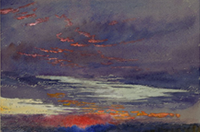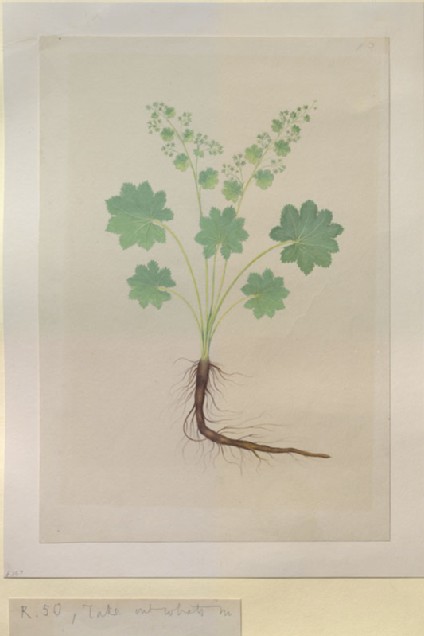Ruskin's Educational series, 2nd ed. (1874)
Ruskin's revised catalogue of 300 works for the instruction of undergraduates and his notes on the use of particular examples.

Ruskin's Catalogues: 1 object
Show search help- Reference URL
Actions
Drawing of an Illustration in the "Herbal of Benedetto Rin", showing an Alchemilla Plant Caldara
-
Ruskin text
257. Alchemilla. Copy of drawing by Andrea Amadio, in illustration of Benedetto Rino’s Herbal . (1415.)The wonderful M.S. in St. Mark’s Library, at Venice, from which this drawing is copied, contains the earliest botanical drawings I know, of approximate accuracy. They are, however, like all previous work, merely suggestive of the general character of the plant, and are very imaginative in details. But I should like you to copy this one, because it will show you the delicacy and care of Venetian school-work; and farther impress on you the Venetian respect for law. Every plant, whatever its own complexity of growth, is reduced in this book to some balanced and ornamental symmetry of arrangement; not, as in our base mechanical schools, by making one side of every leaf or cluster like its opposite, but by making them different, yet lovely in relation.
There is a beautiful piece of fancy in the page representing the common blue chicory. Its current Latin name in the fifteenth century, from its rayed form, was Sponsa Solis. But its blue colour caused it to be thought of asthe favourite, not of the sun only, but of the sky. And the sun is drawn above it with a face, very beautiful, in the orb, surrounded by vermilion and golden rays, which descend to the flower through undulating lines of blue, representing the air. I have never seen the united power of Apollo and Athena more prettily symbolized.
-
Details
- Artist/maker
-
after Andrea Amadio
- Object type
- drawing
- Material and technique
- watercolour and bodycolour over graphite on wove paper
- Dimensions
- 369 x 255 mm (drawing); 417 x 306 mm (mount)
- Inscription
- Recto, top right, in graphite: P 3
On the front of the mount, bottom left, in graphite: E257
On the back of the mount, top right, the Ruskin School's stamp
On a separate rectangular label, in graphite: R. 50 , Take out whats no [sic]
- Provenance
-
Presented by John Ruskin to the Ruskin Drawing School (University of Oxford), 1875; transferred from the Ruskin Drawing School to the Ashmolean Museum, c.1949.
- No. of items
- 1
- Accession no.
- WA.RS.ED.257
-
Subject terms allocated by curators:
Subjects
-
References in which this object is cited include:
References
Ruskin, John, Catalogue of the Educational Series (London: Smith, Elder, 1871), cat. Educational no. XI.5.F
Ruskin, John, Catalogue of the Educational Series (London: Spottiswoode, 1874), cat. Educational no. 257
Ruskin, John, Catalogue of Examples Arranged for Elementary Study in the University Galleries (Oxford: Clarendon Press, 1870), cat. Educational no. 41
Ruskin, John, ‘The Ruskin Art Collection at Oxford: Catalogues, Notes and Instructions’, Edward T. Cook and Alexander Wedderburn, eds, The Works of John Ruskin: Library Edition, 39 (London: George Allen, 1903-1912), 21, cat. Educational no. 257
Location
-
- Western Art Print Room
Position in Ruskin’s Collection
Ruskin's Catalogues
-
Ruskin's Educational series, 1st ed. (1871)
5 F Study of Alchemilla. From a Venetian Herbal of 15th Century . -
Ruskin's Educational series, 2nd ed. (1874)
257. Study of Alchemilla. From a Venetian Herbal of 15th Century. -
Ruskin's Catalogue of Examples (1870)
Alchemilla. Copy of drawing by Andrea Amadio, in illustration of Benedetto Rino’s Herbal . (1415.)The wonderful MSS. in St. Mark’s Library, at Venice, from which this drawing is copied, contains the earliest botanical drawings I know of approximate accuracy. They are, however, like all previous work, merely suggestive of the general character of the plant, and are very imaginative in details. But I should like you to copy this one, because it will show you the delicacy and care of Venetian school-work; and farther impress on you the Venetian respect for law. Every plant, whatever its own complexity of growth, is reduced in this book to some balanced and ornamental symmetry of arrangement.
There is a beautiful piece of fancy in the page representing the common blue chicory. Its current Latin name in the fifteenth century, from its rayed form, was Sponsa Solis. But its blue colour caused it to be thought of as the favourite, not of the sun only, but of the sky. And the sun is drawn above it with a face, very beautiful, in the orb, surrounded by vermilion and golden rays, which descend to the flower through undulating lines of blue, representing the air. I have never seen the united power of Apollo and Athena more prettily symbolized.
I think, then, you cannot be introduced to the practice of colour under better augury than by this good old Venetian herbalist, with his due reverence for aerial and stellar influences; nor by any worthier plant than this wild one of the lowlands and of the hills; which indeed once grew freely with us in divers places, as in the towne pastures by Andover, and also upon the banke of a mote that encloseth a house in Bushey, fowerteene miles from London: and which I doubt not grows now, at least the Alpine variety of it, as it did then, on Bernard’s Hill in Switzerland. And with its fair little folded mantle of leaf, and Arabian alchemy, strong to heal wounds and to prolong youth, it may take happy place, with the white mountain Dryas, among the thornless roses.
And now in beginning colour:—remember once for all (and it is the main meaning of what I said long ago— you are always safe if you hold the hand of a colourist ), that you cannot colour unless you are either happy as a child is happy, or true as a man is true—sternly, and in harmony through his life. You cannot paint without one or the other virtue—peace of heart, or strength of it. Somehow, the very colour fails, itself, under the hand which lays it coldly or hesitatingly. If you do not enjoy it, or are not resolved it shall be faithful, waste no time with it.





